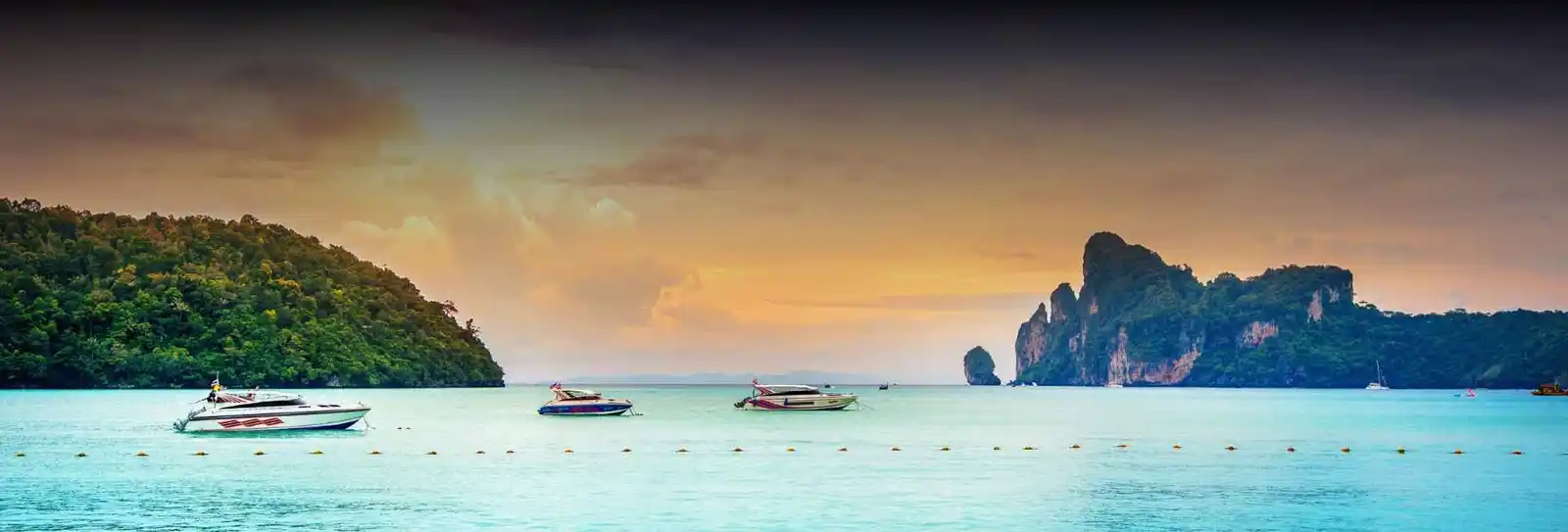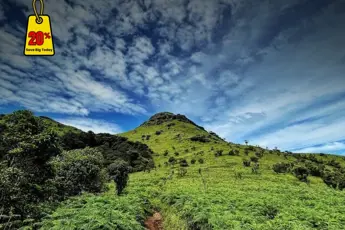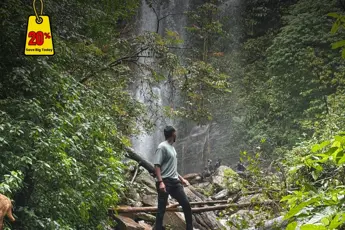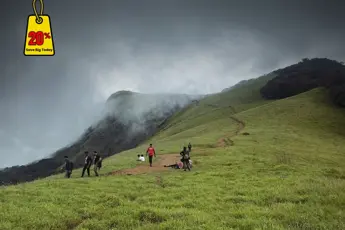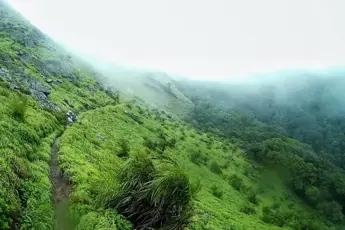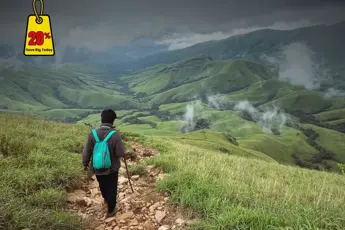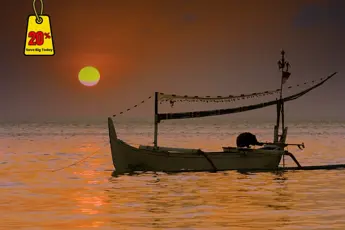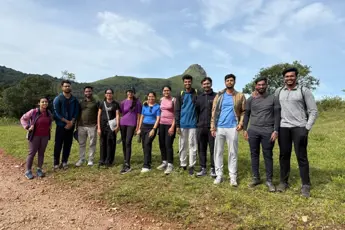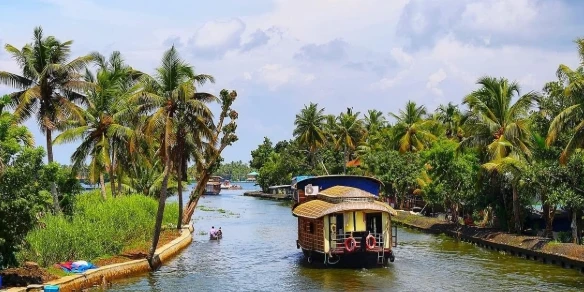
Kerala, or "God's Own Country" as it is often affectionately called, is a paradise of nature, a potpourri of culture and an encyclopedia of biodiversity, a perfect destination for the adventure tourist. It has mountains veiled in a misty shroud and forests green, backwaters shining and some of the best beaches in the world. The landscape of Kerala is diverse, with rich vegetation and wildlife perfect for trekking and exploration. This ultimate adventure holiday is designed for the thrill-seeking traveller who would like to have experiences combining the adventure of outdoor activity with the peace of nature and the true hospitality of locals. Start your emerald Western Ghats experience in Meesapulimala, South India's second-highest point, and trek to scenic Agasthyakoodam with panoramic views, brief wildlife glimpses, and crisp high-altitude air. Trek to Silent Valley National Park's peaceful valleys, a UNESCO biosphere reserve of endemic flora and fauna.Next, head out to Wayanad's rolling hills, scenic hikes to Edakkal Caves and Chembra Peak, renowned for its heart-shaped lake. Add Alleppey backwaters kayaking, Periyar bamboo rafting, and Bekal or Varkala beach camping to your treks. The tour is also a potential for cultural pursuits like Kathakali performances, Kerala cuisine, and overnight stays in nature-surrounded eco-holiday homes and treehouses. Nature lovers are offered the opportunity of staying amid elephants, tigers, and other birdlife at Periyar Wildlife Sanctuary and Thattekad Bird Sanctuary. Whether a seasoned trekker or nature-loving, eco-sensitive tourist seeking something beyond the usual, Kerala's diverse landscape, friendly people, and eco-tourism attitude are the setting for an adventure to be savoured. This trek guarantees you experience Kerala's pristine natural beauty in its finest form, in addition to exposing you to its heritage and serenity. Venture more to sample Kerala on a whole new level on foot, by canoe, and in awe.History of Discovery and Trekking in KeralaThe history of discovery and trekking in Kerala is, naturally, all connected with its ancient connection with religion, trade, and nature. The state's diversified topography, varying from sea-fringing plains to hill Western Ghats, has alternatively been a barrier and bridge over the centuries, conferring cultural and environmental diversity to the state. Before this, the Kerala hill ranges were utilised by tribal people, sages, and spice traders who travelled through hill forests and hilly roads for centuries. Later, the roads became significant trade routes in the spice boom era when Kerala attracted spice traders from Arabia, China, and Europe. Kerala's ancient spice route along the Western Ghats, particularly in regions like Wayanad and Thekkady, is are trekking base today, tracing history's footprint. The area is also blessed with spiritual and mythological importance, with trekking. Mountains such as Agasthyakoodam are not only trek points but also spiritually holy places. Agasthyakoodam is said to be the abode of Sage Agastya, one of the Saptarishis, and is dedicated to most of the believers who make the trek a religious pilgrimage.Contemporary adventure tourism within Kerala also started to pick up pace towards the close of the 20th century in several eco-tourism sectors that were focusing on conservation and green tourism. Private enterprise and following government policy-making brought about future arrangements of trekking trails to Meesapulimala, Chembra Peak, and Silent Valley. Such developments are sustainability-focused with minimal environmental degradation accompanied by a participatory experience. Therefore, Kerala's trekking culture is a mix of nature, adventure, and tradition. It welcomes the trekkers to walk where spice traders and seers have walked, to discover biodiversity unrivalled on the planet, and to discover themselves in a land where every trail has a tale. From the ancient tracks to the new trails, Kerala's history of discovery continues to ignite the hearts of adventurers on the planet.Top Trekking Locations in KeralaMeesapulimala: Second second-tallest in South India (2,640 meters), adventure paradise, Meesapulimala. High-altitude grassland trek, tea plantation trek, and shola forest trek, with viewpoint spotting and spotting endemic wildlife.Agasthyakoodam: Within the Neyyar Wildlife Sanctuary, Agasthyakoodam is a paradise for trekkers and a pilgrimage centre. It's suitable for short periods and by permission. It's famous for biodiversity, abundance and sanctity.Chembra Peak: Close to Wayanad is Kalpetta with Chembra Peak, renowned for a heart-shaped lake and view with a view. The moderately challenging trek follows tea estates and dense jungle, and so becomes one of Kerala's more romantic treks.Wayanad Hills (Edakkal Caves Trek): It is a history and adventure trek. There are Edakkal Caves with prehistoric carvings, and the product of a challenging yet fruitful hike with bird's-eye views of the Wayanad plateau.Silent Valley National Park: No trekking site in the sense, the UNESCO World Biosphere Reserve has arranged nature treks through ancient rainforests. Ideal for nature lovers who would love to do some eco-trekking and bird watching.Ramakkalmedu: This border town of Kerala-Tamil Nadu offers short treks with a bird's-eye view of the Western Ghats and surrounding windmills. Less crowded and better suited for serene nature walks.Dhoni Hills, Palakkad: Less less-travelled forest trek leads to an inaccessible falls. Suitable for beginners and nature trekkers.Ponmudi Hills: Situated close to Thiruvananthapuram, Ponmudi is a destination with simple treks over rolling hills, valley fog, and tea estates. Ideal for a weekend getaway.Chimmini Wildlife Sanctuary: A Wildlife sanctuary in Thrissur offers forest walks and rafting on bamboo. Ideal for those who are nature lovers and want to experience something adventurous.Vellari Mala: Camel's Hump Mountains is also the nickname given to this as it is the most challenging trek in Kerala. River crossings, waterfalls, and forest on the way are ideal for experienced hikers.Wonders of KeralaBackwaters of Kerala: The Alleppey-Kumarakom-Kollam chain of lakes, lagoons, and canals is a magical and enchanting experience. A boat ride in houseboats through peaceful waterways between coconut groves and rural simplicity is a Kerala traditional experience.Western Ghats and Hill Stations: World Heritage Western Ghats abound with scenic hill stations such as Munnar, Wayanad, and Thekkady. They have green tea plantations, a healthy climate, valuable herbs and wildlife, and one of India's finest trekking routes.Athirappilly Waterfalls: Even called the "Niagara of India," Athirappilly Falls is Kerala's biggest waterfall. Situated in Thrissur, it falls majestically 80 feet in height, teasing the eyes with the expansive view of a wide range, particularly during monsoon.Varkala and Kovalam Beaches: Kerala beach is scattered with a few beautiful beaches. Varkala Beach, sea view cliff and springs, and Kovalam Beach, a crescent-shaped beach, are ideal for recreation and adventure sports.Periyar Wildlife Sanctuary: Located at Thekkady, this sanctuary offers an opportunity to see elephant, tiger, and exotic birds, and to experience bamboo rafting and take part in jungle safaris as well, and hence becomes a nature lover's paradise.Cultural Heritage of Kerala: Aside from Onam and Thrissur Pooram festival, classical dance types like Kathakali, Theyyam, and Mohiniyattam add cultural value to Kerala's terrain. Synagogues, churches, and ancient temples speak of their multi-religious character.Ayurveda and Spa Retreats: Ayurveda has its origins in Kerala, and Kerala spas have authentic healing treatments for rejuvenation, relaxation, and wellness with traditional holistic remedies.Edakkal Caves: Edakkal Caves of Wayanad have ancient rock engravings dating thousands of years and are therefore an unparalleled archaeological marvel.Padmanabhaswamy Temple: The most affluent and most stunning temple in the world, the temple at Thiruvananthapuram, is famous for its Dravidian style and treasure trove.Munroe Island: Surrounded when Kallada River and Ashtamudi Lake, it offers another rural Kerala setting with coir business and backwater cruising, and peaceful backwater life.Best Time to Visit KeralaWinter (October–February): The ideal and best time to visit Kerala is in winter. It is 18°C to 30°C with a pleasant and cool climate, and hence a good time to visit Munnar and Wayanad hill resorts, Alleppey backwater houseboat tour, and sunbathing at the beaches of Varkala and Kovalam. It is suitable for Western Ghats trekking, wildlife safari, and adventure activities as well. It overlaps with Christmas and New Year holidays, and hence festive but highly crowded and costly.Summer (March to May): Summer is hot and humid in Kerala, especially in the plains and coastal regions, with temperatures of 35°C and above. But it is more than fine to head to hill resorts that are cooler, like Thekkady, Vagamon, and Munnar. Off-season during these months, and also pocket-friendly on hotel tariffs as well as on excursions. It is the ideal time to get an Ayurvedic treatment and spa retreat since the traditional doctors believe the treatments will be more potent in summer.Monsoon (June to September): God's Own Country, Kerala, is best experienced in monsoon with lush landscapes, refreshed waterfalls, and peaceful surroundings. Though trekking and outback excursions will be disrupted by incessant rains and soggy roads, monsoons are the favourite option for Ayurvedic rejuvenation therapy due to humid weather conditions that enhance the body’s skin’s ability to uptake herbal oils. It is also the right option for honeymooners who desire secluded retreats, fewer tourists, and inspiring sights. There will be intermittent disruptions to travel due to rain.How to Reach KeralaBy Airport: Kerala is highly accessible by air in the form of four international airports: Trivandrum (Thiruvananthapuram), Kochi (Cochin), Calicut (Kozhikode), and Kannur. All of them have frequent domestic and international flights from all major Indian cities and other foreign countries. Tourists can select the nearest airport according to their trekking destination. Kochi, for example, is very convenient for Munnar and Thekkady as well as for Kumily, and Calicut is for those tourists who are approaching Wayanad.By Train: Kerala has a vast rail network with over 200 railway stations in the state. Thiruvananthapuram Central, Ernakulam Junction (Kochi), Kozhikode, and Kottayam are a few of the major train stations. Trains from the major Indian cities such as Delhi, Mumbai, Chennai, and Bangalore have convenient and beautiful routes to Kerala. One can take a train to the nearby town and then a local taxi or a bus, which is not expensive.Why Book with escape2exploreWhen exploring Kerala from Bengaluru and beyond, escape2explore stands out as a trusted name in adventure and experiential travel. Here’s why hundreds of travellers choose us for their getaways:Trusted, Well-Reviewed Local Operator: escape2explore has gained the trust of thousands of content tourists all over India. With persistent positive feedback and an unblemished reputation for delivering quality experiences, we assure you that your experience will be hassle-free, memorable, and value-packed. Our insider local knowledge guarantees that you will always be in safe hands.Seasoned Guides: Our trips are led by friendly, trained, and professional guides who are passionate about the outdoors and your safety. Whether it's a beach trek, a cultural tour, or a spiritual walk through temples, our team knows the terrain, the stories, and how to make each moment count.Safe & Curated Itineraries: Your safety is our number one priority. Our tour packages are thoughtfully crafted with safety measures, researched accommodations, and easy travel arrangements. We take care of the details so you can have the experience hassle-free and worry-free.Unique Experience That You Won't Find Anywhere Else: With escape2explore, you discover more than the tourist attractions. We go off the beaten track with hidden beaches, unusual treks, offbeat cultural destinations, and true interactions.Read: Sustainable Travel in India |Dream Trip to India |Active and Relaxing Trips in India |Maharastra hidden Trails |Easy Treks in India


